Description
Arm lift (brachioplasty) is a surgical procedure performed to tighten the arms due to laxity from aging or significant weight loss. arm lift involves removal of excessive, hanging skin (and underlying fat, if necessary) through a long vertical incision on the inner aspects of the arm. Although the scar is concealed with the arms down, it is visible with the arm raised.
Arm Lift Before and After Photos

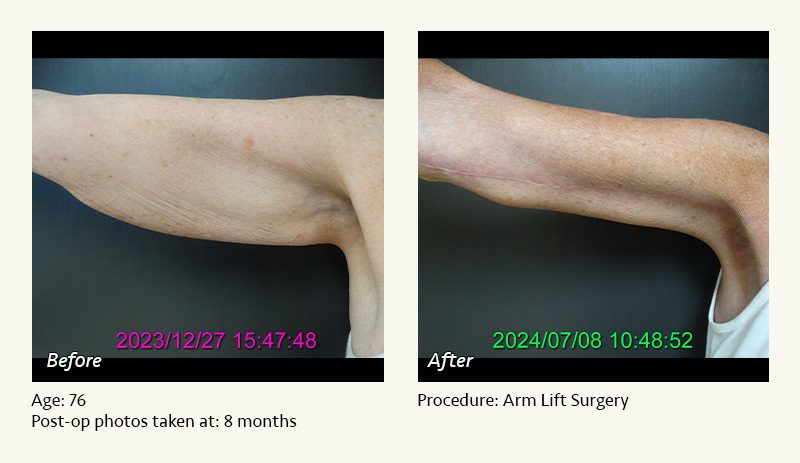
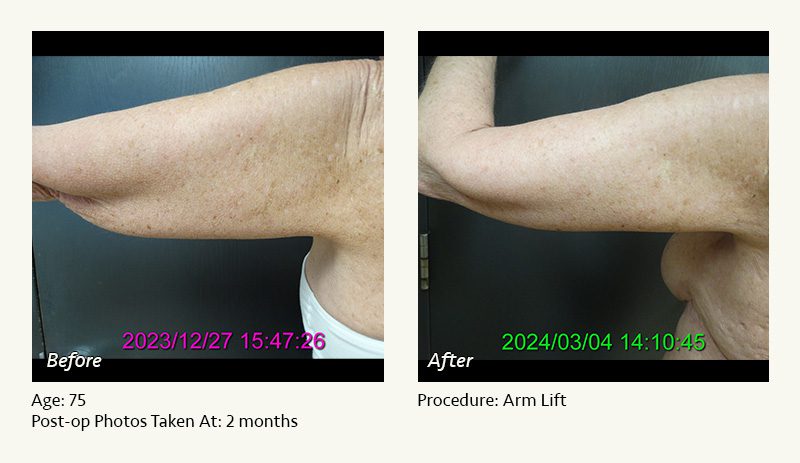
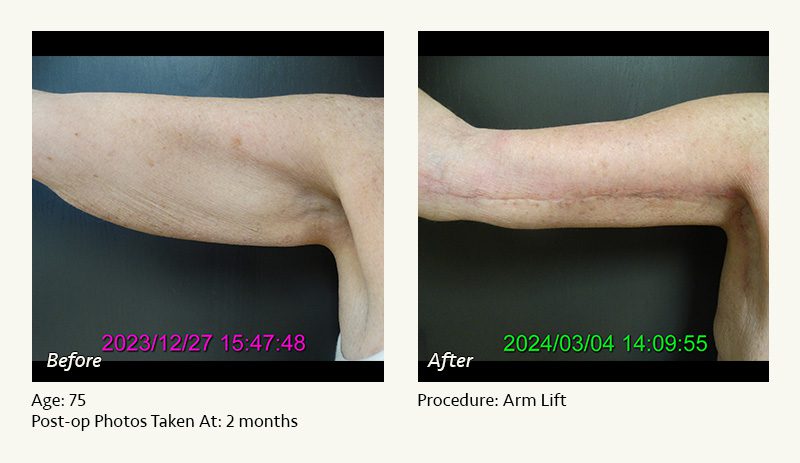
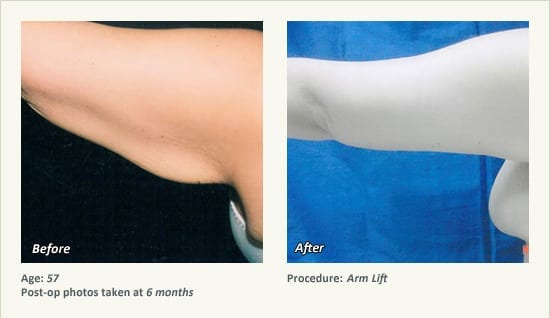
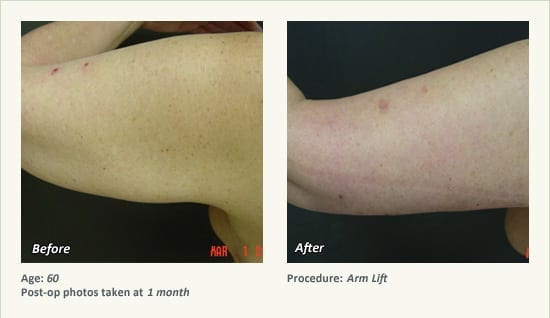
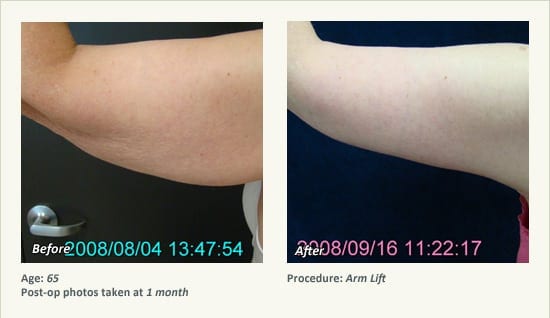
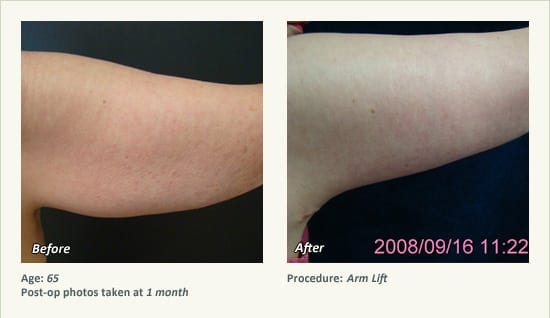
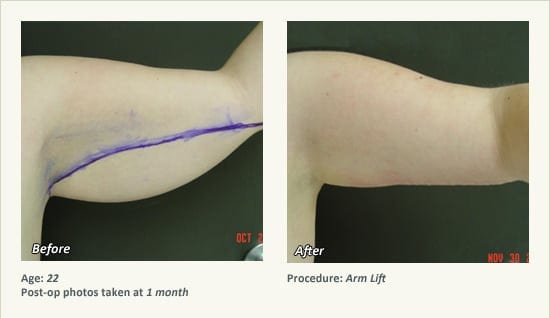
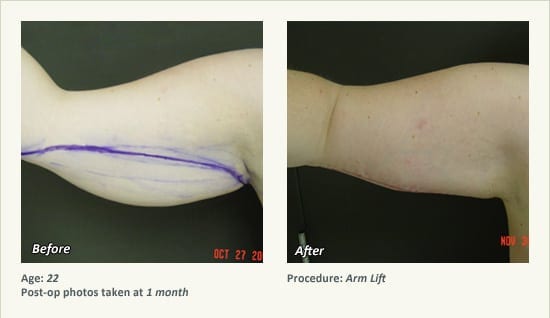
Dr. Friedman performs arm lift under general anesthesia on an outpatient basis. The procedure is performed in his AAAASF-accredited surgical facility, the West Plano Plastic Surgery Center, which is located on the campus of Texas Health Presbyterian Hospital of Plano. He strictly uses physicians—not nurses or technicians—to administer your anesthesia.
Pain is usually moderate and well-controlled with prescription pain medication. Most patients return to light activities within 3 to 5 days. To reduce swelling, an arm compression garment is worn for the first 3 to 4 weeks after surgery. All stitches are internal; there are no stitches or staples to remove. Heavy straining should be avoided for about 4 weeks. Improvement in arm laxity is generally apparent immediately after surgery, but final results may take 12 months.
When you visit our office in Plano, Texas Dr. Friedman will discuss your particular problems and concerns. He will give you a realistic expectation of what you can expect from surgery. We will also show you “before and after” photos of arm lifts Plano patients performed by Dr. Friedman . If you wish to speak to other patients who have undergone this surgery, we will be happy to provide phone numbers.
Q & A: Arm lift
-
Do I need an arm lift? Or can I just have liposuction of the arms?
Liposuction of the arms is useful for patients with a limited amount of excess fat of the arms that is unresponsive to dieting and exercise. Liposuction is most successful in patients with reasonably good skin tone. Arm lift is useful for patients with a large amount of excess skin with or without some excess fat.
-
What’s the best thing about arm lift?
The best thing about arm lift is the removal of hanging skin (which some people refer to as “bat wings”). This makes the arms slimmer, more attractive in shape, and allows more clothing options.
-
What’s the worst thing about arm lift?
The worst thing about arm lift is the scars, which extend on the inner arms from the armpits to the elbows. These are reasonably concealed with the arms down and do fade significantly with time. But they are clearly a significant trade-off.
-
I plan to lose a lot of weight. Should I do an arm lift now or wait?
Wait. It is best to be within about 10 to 20 pounds of your planned long-term weight prior to arm lift. The more weight you lose prior to surgery, the more skin excess Dr. Friedman can remove during surgery. Major weight loss after arm lift surgery may cause some recurrent skin excess. If you maintain a stable weight after surgery, your results will generally be long lasting.
-
Will there be drainage tubes after arm lift surgery?
Dr. Friedman generally places arm compression sleeves after surgery. These are worn for at least 2 weeks continuously after surgery, helping to reduce swelling and maintain your contour. He generally does not use drains for arm lift.
Arm lift: Instructions
One week before surgery
- Do not take aspirin-containing products, as these may increase your risk of bleeding. Use extra-strength Tylenol for any headaches or other minor pains.
- Please notify Dr. Friedman’s staff if you become sick with a fever, significant cough, etc. If necessary, your surgery can be rescheduled to a time when you are feeling better.
- Do not smoke at all or use a nicotine patch for at least two weeks (and preferably 4 weeks) prior to surgery and 4 weeks after surgery. Smoking interferes with wound healing and increases your risk for anesthetic and surgical complications.
- Arrange to have a relative or friend drive you home after surgery and stay with you for the evening. You cannot drive yourself home.
The evening before surgery
- Do not eat or drink anything for at least 8 hours prior to your scheduled surgery time.
- Make some jello and/or soup for after surgery. Have some juice in your refrigerator.
- The anesthesiologist will contact you by phone to discuss your medical history and to answer any questions.
Day of surgery: before you leave home
- Remember not to eat, drink, or smoke. This includes no chewing gum, mints, etc.
- Make sure someone is available to drive you home. Put a pillow and blanket in the car.
- Wear loose, comfortable clothing. Avoid heavy make-up, jewelry, or contact lenses. Please do not use any lotion, baby oil, perfume or powder. LEAVE ALL VALUABLES AT HOME!
Day of surgery: at the facility before surgery
- Dr. Friedman will talk to you before surgery to answer any last-minute questions. He will mark your areas of undesirable skin and fat to help him accurately plan your surgery.
- You will meet the anesthesiologist and surgical nurses.
Day of surgery: at the facility after surgery
- You will be taken to the recovery area to wake up after surgery. Dr. Friedman will go to the waiting room to speak to your family/friends.
- Approximately 1 hour later, your family can visit you. Once you are feeling well enough, you may go home.
At home after surgery
- Have someone stay with you for the first night. You may be weak and drowsy.
- Take the antibiotics, pain medication (as needed), and anti-nausea medicine (if needed) that Dr. Friedman has prescribed for you.
- Sleep with your head elevated. Sleep on your back (not your stomach or side).
- Keep your arm compression sleeves clean and dry; do not remove them. You may use soap and a wet washcloth to cleanse all other body areas.
- It is common to experience temporary drainage from the incision sites, which may be blood-stained. If the drainage is bloody and persistent, contact Dr. Friedman.
- Take at least 10 deep breaths every hour. This will help keep your lungs expanded.
- Do not be a couch potato. To reduce the risk of blood clots in the legs, get up and walk any time you need to eat or use the bathroom. While you are in bed, repeatedly flex your ankles (moving your toes up and then down) and/or have your family massage your calves.
- If you experience a prolonged fever (oral temperature greater than 101), contact Dr. Friedman. Feel free to call our office or to page Dr. Friedman for any other problems or concerns.
Instructions for your first postoperative visit (about 3 days after surgery)
- Activity level
1 week after surgery: you may resume casual walking but must not engage in vigorous exercise that increases your blood pressure or heart rate. You may resume driving once you are off of your pain medication. Avoid freeways until you are comfortable with city driving.
4 weeks after surgery: you may gradually resume light exercise activity (if permitted by Dr. Friedman). You should wear your compression garment during any exercise. You may not perform arm exercises for 6 weeks. - Sleeping position
Please sleep on your back (with your head elevated and a pillow under your knees) or part way over (pillow under your shoulder and hip). Do not sleep on your side or stomach until about 3 weeks after surgery. - Incision care
You have a layer of tissue glue to seal your incision. After this peels off (about 2 weeks after surgery), begin scar massage with Mederma twice daily. Mederma is available at our front desk or over-the-counter at your pharmacy. If you prefer, you may use Vitamin E or Aloe Vera. Continue scar massage for about 3 months. - Massage
You should begin massage to the suctioned one week after surgery. This will help smooth any irregularities and areas of firmness. You may apply lotion to your hand to massage and/or you may use a vibrating massager. If you would like, we will provide you the phone number of a licensed massage therapist. - Water exposure
You may shower daily after your first postoperative appointment. You should avoid scrubbing your incisions. Avoid the pool, lake, and ocean for 4 weeks. - Medications
One week after surgery, you may resume use of any medications or supplements that you discontinued prior to surgery. However, for at least 3 weeks, you should avoid Motrin, aspirin, and any other product that may thin your blood. - Smoking
Do not smoke for at least one month (and preferably much longer) after surgery. Smoking may increase your risk of infection, lung problems following anesthesia, and wound healing problems. - Tanning
You may tan whenever you like. However, you should use a high-SPF sunscreen (30 or greater) over your incisions for at least 6 months. Premature tanning of the incisions may cause them to darken permanently. - Sex
You may resume intercourse about 3 weeks after surgery. - Compression garment
Wear the compression garment all day and all night (except for showers and massage) during the first 4 weeks. Wear the garment on a tapering basis for the next 4 weeks.
Please feel free to ask Dr. Friedman or his staff about any additional questions or concerns and call our office located in Plano, TX for a consultation